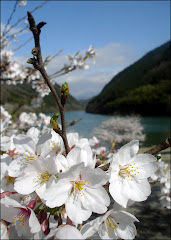"GOBLINS OUT! FORTUNE IN!"

The Long-Nosed Goblin of Mt. Atago: Performed by the geiko of Gion Higashi. During setsubun, many people hang Okame masks (thought to bring good luck), like the one above.

The Long-Nosed Goblin of Mt. Atago: Performed by the geiko of Gion Higashi. During setsubun, many people hang Okame masks (thought to bring good luck), like the one above.
According to ancient Chinese legend, a man-eating mountain-dwelling beast called the nian (年) silently slipped in and out of houses, preying on unsuspecting villagers. In time, people learned that loud noises and the color red seemed to repel the monster, and began to protect themselves with explosions, fireworks displays and the use of the color red in their homes and villages. Eventually these customs evolved into the first Chinese New Year celebrations. Even the kanji for Guò nián (Simplified Chinese: 过年; Traditional Chinese: 過年), which means to celebrate the new year, literally means 'the passing of the nian beast".
The legend of nian and the traditions adopted to repel him became so intwined with the idea of the new year that, when the Japanese began using chinese characters in their writings, the kanji for the nian (年) came to mean 'year'.
 A long-nose oni (goblin, devil) mask.
A long-nose oni (goblin, devil) mask.In traditional Japan, the new year celebrations began with Risshun (立春) Setsubun (節分), the day before the begining of Spring (according to the traditional East Asian calendar). As with modern celebrations of the Gregorian New Year, special rituals were performed to cleanse the misfortune of the former year and drive away evil spirits in the year to come.
As in China, the celebrations were not without their hideously evil creatures. The devilish Oni were originally invisible spirits or gods which caused disasters, disease, and other general unpleasantness in the lives of humans, taking on a variety of forms to deceive (and often devour) them. The Chinese character (鬼) meaning "ghost" came to be used for these formless creatures. It was not until Buddhism arrived that Oni took on its present ogre-like form.
As in China, the celebrations were not without their hideously evil creatures. The devilish Oni were originally invisible spirits or gods which caused disasters, disease, and other general unpleasantness in the lives of humans, taking on a variety of forms to deceive (and often devour) them. The Chinese character (鬼) meaning "ghost" came to be used for these formless creatures. It was not until Buddhism arrived that Oni took on its present ogre-like form.
In Japan, these beasties were much easier to keep at bay. On this traditional New Year's Eve, the toshiotoko (man born on in the corresponding animal year of the Chinese zodiac or the head of the house) would throw pan heated soy beans out the door or at a family member wearing an oni mask yelling "Oni wa soto! Fuku wa uchi!" (Evil spirits out! Fortune (blessing) in!" The beans were believed to purify the home, driving out the spirits of sickness and misfortune. To ensure that good luck would enter, the soybeans were eaten. In some areas, the number of bean one eats is the same as their age, but in some places an extra bean is added for good luck. Mamemaki, or bean throwing, still happens today.
I'm off to Kyoto to experience mamemaki myself! Happy Setsubun! Fuyu was soto! Haru was Uchi! (Out with winter! In with Spring!)
I'm off to Kyoto to experience mamemaki myself! Happy Setsubun! Fuyu was soto! Haru was Uchi! (Out with winter! In with Spring!)




No comments:
Post a Comment